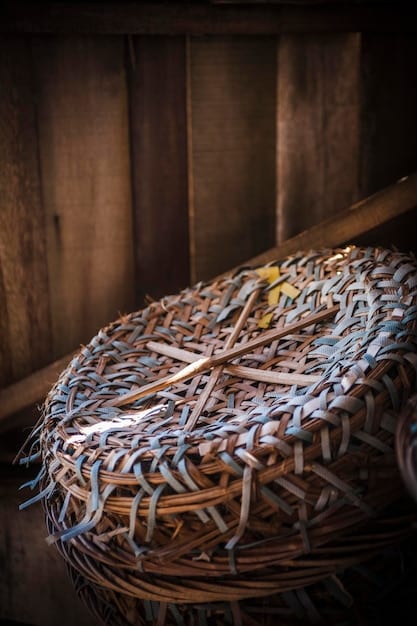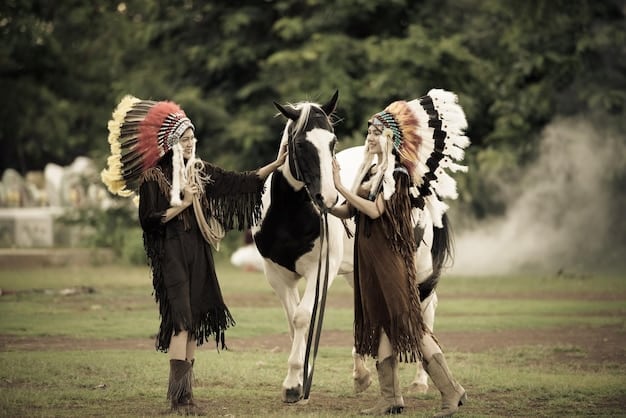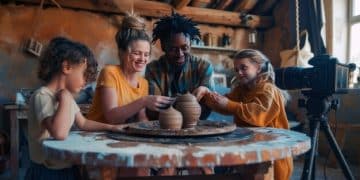Experience Native America: Immersive Cultural Journeys in Tribal Lands

Exploring America’s Native Heritage: Immersive Cultural Experiences on Tribal Lands offers unique and authentic opportunities to connect with the rich traditions, histories, and contemporary lives of diverse Native American communities across the United States.
Embark on a transformative journey and exploring America’s Native Heritage: Immersive Cultural Experiences on Tribal Lands, allowing you to witness firsthand the vibrant tapestry of traditions, stories, and resilience that define these unique communities.
Unveiling the Richness of Native American Heritage
Native American culture is woven into the very fabric of the United States, offering a profound and often overlooked perspective on the nation’s history and identity. Exploring this heritage provides a chance to understand the deep connection between people and land, and to learn from traditions passed down through generations.
Immersive experiences on tribal lands offer unparalleled opportunities for cultural exchange and understanding. By engaging directly with Native communities, visitors can gain insights into their values, beliefs, and ways of life.
The Importance of Cultural Sensitivity
When engaging with Native American cultures, it’s crucial to approach with respect and sensitivity. Understanding the historical context and the impact of colonization is essential for fostering genuine connections and avoiding cultural appropriation.
- Learn about the specific tribe’s customs and protocols before visiting.
- Ask permission before taking photos or videos of people or ceremonies.
- Support Native-owned businesses and artists to contribute directly to their communities.
Respecting tribal sovereignty and cultural practices is paramount to ensuring a positive and mutually beneficial experience.
Immersing yourself in Native American culture, one can discover unique traditions and respect the roots of the nation. The understanding promotes harmony and a deeper sense of appreciation.

Navajo Nation: A Journey Through Ancient Lands
The Navajo Nation, spanning across Arizona, New Mexico, and Utah, invites travelers to explore its breathtaking landscapes and discover its rich cultural heritage. With its iconic Monument Valley and Canyon de Chelly, the Navajo Nation offers a visual feast and a deep dive into Diné (Navajo) culture.
Visitors can explore ancient ruins, witness traditional ceremonies, and learn about the Navajo people’s deep connection to their ancestral lands.
Experiencing Navajo Hospitality
Hospitality is a cornerstone of Navajo culture. Visitors are often welcomed with open arms and invited to participate in traditional activities, offering a glimpse into their way of life.
Stay in a traditional hogan, learn about Navajo weaving techniques, and savor authentic Navajo cuisine.
- Attend a traditional Navajo rug auction and witness the artistry firsthand.
- Explore Canyon de Chelly with a Navajo guide and learn about its history and significance.
- Visit the Navajo Nation Museum in Window Rock, Arizona, to delve deeper into Diné culture.
These interactions foster meaningful connections and promote cross-cultural understanding, ensuring a memorable experience.
The Navajo Nation’s blend of stunning landscapes and vibrant culture offers visitors transformative experiences and insights into America’s native heritage.
Pueblo Cultures: Echoes of Ancestral Voices
In New Mexico, the 19 Pueblos each offer unique cultural experiences, reflecting centuries of tradition and resilience. These ancient communities invite visitors to witness their vibrant ceremonies, explore their historic sites, and learn about their distinct cultural identities.
From the adobe architecture of Taos Pueblo to the pottery traditions of Acoma Pueblo, each Pueblo offers a unique glimpse into a rich and enduring heritage.
Witnessing Pueblo Dances and Ceremonies
Pueblo dances and ceremonies are powerful expressions of their cultural beliefs and traditions. These events are often open to the public, providing a rare opportunity to witness the beauty and spiritual significance of these ancient practices.
Remember to be respectful and observe the guidelines provided by the Pueblo community.
- Visit the Indian Pueblo Cultural Center in Albuquerque to learn about the history and culture of all 19 Pueblos.
- Attend a feast day at one of the Pueblos and witness traditional dances and ceremonies.
- Explore the ancient ruins of Bandelier National Monument and learn about the ancestral Pueblo people who once lived there.
Attending these events provides a unique window into the heart of Pueblo culture.
Pueblo cultures offer rich traditions and historical depth to enrich understanding, showcasing the enduring aspects of America’s native heritage.

Powwows: Celebrations of Native American Identity
Powwows are vibrant gatherings that celebrate Native American culture through music, dance, and competition. These intertribal events bring together Native people from across the country to share their traditions, reconnect with their heritage, and honor their ancestors.
Visitors are welcome to attend powwows and experience the energy and beauty of these cultural celebrations.
Understanding Powwow Etiquette
While powwows are open to the public, it’s essential to understand and respect the cultural protocols. Dress respectfully, ask permission before taking photos or videos, and listen to the announcements for guidance.
Support Native vendors by purchasing handcrafted items and learn about the different dance styles and regalia.
Experience the rhythm, color, and community that define these vibrant cultural celebrations.
Powwows offer an experience which celebrates and promotes cultural unity, sharing important aspects of America’s native heritage.
Native American Cuisine: A Taste of Tradition
Native American cuisine reflects the deep connection between people and the land, utilizing traditional ingredients and techniques that have been passed down through generations. Exploring Native American cuisine offers a unique opportunity to savor the flavors of the past and discover the culinary innovations of the present.
From traditional dishes like frybread and hominy to contemporary interpretations of Native ingredients, Native American cuisine offers a diverse and flavorful culinary landscape.
Savoring Authentic Flavors
Seek out Native-owned restaurants and food vendors to experience authentic Native American cuisine. Learn about the cultural significance of the ingredients and the stories behind the dishes.
Try traditional dishes like Navajo tacos, Pueblo green chile stew, and wild rice pilaf. Support Native farmers and producers by purchasing locally grown ingredients.
- Visit the Mitsitam Native Foods Cafe at the National Museum of the American Indian in Washington, D.C., to sample dishes from across Native America.
- Attend a Native American food festival and discover the diverse culinary traditions of different tribes.
- Take a cooking class with a Native American chef and learn how to prepare traditional dishes.
Native American cuisine can be a very rich and diverse, offering a unique taste of American heritage.
Exploring Native American cuisine provides both flavors that capture the history from ingredients, thus providing a lasting impression about American heritage.
Supporting Native American Communities Through Tourism
Responsible tourism can play a vital role in supporting Native American communities and preserving their cultural heritage. By choosing to visit tribal lands and engaging in culturally sensitive activities, visitors can contribute directly to the economic well-being of these communities and help to ensure the survival of their traditions.
Support Native-owned businesses, artists, and cultural organizations. Respect tribal sovereignty and cultural protocols.
Making a Positive Impact
Choose tour operators that prioritize cultural sensitivity and community benefit. Learn about the challenges facing Native American communities and advocate for policies that support their rights and self-determination.
Educate yourself and others about Native American history and culture. Share your experiences with friends and family to promote awareness and understanding.
Tourism can contribute to sustainable development and foster meaningful connections between visitors and Native communities.
By embracing social responsability, tourists can enable the empowerment of native communities, thus ensuring the preservation of legacy and culture, contributing to American heritage.
| Key Aspect | Brief Description |
|---|---|
| 🏞️ Navajo Nation | Explore stunning landscapes and immerse in Diné culture. |
| 🏺 Pueblo Cultures | Experience ancient traditions and unique cultural identities in New Mexico. |
| 🥁 Powwows | Join vibrant celebrations of Native American culture through music and dance. |
| 🍽️ Native Cuisine | Savor traditional flavors and discover culinary innovations reflecting heritage. |
[Frequently Asked Questions]
What is cultural sensitivity and why is it important?
Cultural sensitivity involves respecting the customs, traditions, and beliefs of indigenous communities, which is crucial for fostering positive interactions.
Are powwows open to the public, and what is the proper etiquette?
Yes, powwows are generally open to the public. Proper etiquette includes dressing respectfully and seeking permission before taking photos.
How can tourism support Native American communities?
Tourism supports Native American communities by creating economic opportunities and helping preserve cultural heritage through responsible engagement.
What are some traditional Native American dishes?
Traditional Native American dishes include frybread, hominy, and Navajo tacos, reflecting a rich history of indigenous ingredients.
Where can I experience authentic Native American cuisine?
Authentic Native American cuisine can be experienced in Native-owned restaurants. Always seek for the most traditional forms of preparation within the tribes.
Conclusion
Exploring America’s Native Heritage by embracing the culture experiences offers unparalleled opportunities to immerse oneself in the beauty, art, richness, and resilience of the United States’ first peoples. By approaching these experiences with respect, sensitivity, and a commitment to supporting Native American communities, visitors can forge meaningful connections, broaden their understanding, and contribute to the preservation of this vital part of American culture.






